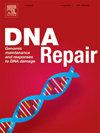Innate immune sensing and signaling: Co-opted for genome surveillance? Implications for tumorigenesis
IF 2.7
3区 生物学
Q2 GENETICS & HEREDITY
引用次数: 0
Abstract
Innate immune signaling is traditionally associated with the response to pathogenic infection. However, emerging evidence suggests that nuclear innate immune sensors and their downstream pathways may also serve as a critical mechanism for genome surveillance. This review explores a model in which DNA sensors such as mouse IFI204 and IFI205 (IFI16 in humans) localize to replication forks, where they detect endogenous aberrant DNA structures and initiate an interferon-stimulated gene (ISG) transcriptional program. A key output of this transcriptional program is ISG15, which we find conjugated to fork-associated proteins and facilitates recruitment of the replication fork protection complex, thereby stabilizing replication forks under physiological conditions. We discuss how nuclear innate immune sensors mediate replication stress sensing and examine the broad consequences of downstream ISG transcription across diverse contexts—including its impact on genome stability and its dual roles in modulating tumor cell behavior and the tumor microenvironment. These findings suggest that the innate immune system, through its nuclear DNA sensing arm, may be evolutionarily co-opted for genome surveillance and may influence tumor initiation and therapy resistance. Understanding how innate immune signaling intersects with replication stress could offer mechanistic insights into tumor development and reveal novel therapeutic targets.
先天免疫感知和信号传导:基因组监测的增选?对肿瘤发生的影响
先天免疫信号通常与致病性感染的反应有关。然而,新出现的证据表明,核先天免疫传感器及其下游途径也可能作为基因组监测的关键机制。这篇综述探讨了一种模型,其中DNA传感器如小鼠IFI204和IFI205(人类IFI16)定位于复制叉,在那里它们检测内源性异常DNA结构并启动干扰素刺激基因(ISG)转录程序。该转录程序的一个关键输出是ISG15,我们发现它与叉相关蛋白结合,促进复制叉保护复合体的招募,从而在生理条件下稳定复制叉。我们讨论了核先天免疫传感器如何介导复制应激感应,并研究了下游ISG转录在不同背景下的广泛影响,包括其对基因组稳定性的影响及其在调节肿瘤细胞行为和肿瘤微环境中的双重作用。这些发现表明,先天免疫系统通过其核DNA传感臂,可能在进化中被用于基因组监测,并可能影响肿瘤的发生和治疗耐药性。了解先天免疫信号如何与复制应激相交,可以为肿瘤发展提供机制见解,并揭示新的治疗靶点。
本文章由计算机程序翻译,如有差异,请以英文原文为准。
求助全文
约1分钟内获得全文
求助全文
来源期刊

DNA Repair
生物-毒理学
CiteScore
7.60
自引率
5.30%
发文量
91
审稿时长
59 days
期刊介绍:
DNA Repair provides a forum for the comprehensive coverage of DNA repair and cellular responses to DNA damage. The journal publishes original observations on genetic, cellular, biochemical, structural and molecular aspects of DNA repair, mutagenesis, cell cycle regulation, apoptosis and other biological responses in cells exposed to genomic insult, as well as their relationship to human disease.
DNA Repair publishes full-length research articles, brief reports on research, and reviews. The journal welcomes articles describing databases, methods and new technologies supporting research on DNA repair and responses to DNA damage. Letters to the Editor, hot topics and classics in DNA repair, historical reflections, book reviews and meeting reports also will be considered for publication.
 求助内容:
求助内容: 应助结果提醒方式:
应助结果提醒方式:


